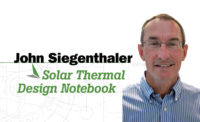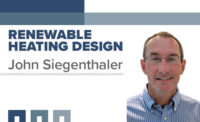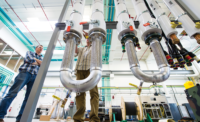When our master bathroom was featured on the cover of a 1999 issue of Radiant Living magazine, the article revealed many improvements the house had received over its life. Many of those improvements have been hydronic in nature; now nature plays a major role in the hydronics of this South Dakota home.
The house became a showcase of — and for — many products and services that were offered by Howard Heating & Plumbing, which was founded by my grandfather Francis “Buttsy” Buttenob in 1938.
Grandpa purchased the property just outside of town (really, he bought the farm) in 1956, moved the business and modernized the home to include, among other things, a state-of-the-art oil-fired, zoned, Mono-flo, cast-iron baseboard hydronic heating system. This system was removed when radiant floors were installed throughout the home.
The description of the heating system featured in that 1999 article had one more step that was not revealed. That step was a dream to incorporate geothermal, which in turn has grown into additional steps and the organization of another business.
The original dream was to marry a low-temperature energy source with a low-temperature distribution system. This was done through the implementation of a multisource/sink heat pump, also known in the industry as a water-source or geothermal heat pump. That multisource/sink heat pump is the heart and transitional component to connect nature via hydronics to the radiant heating distribution system, as well as chilled water coil to replace the direct expansion coil that was being used in the high-velocity air-conditioning system.
When I discussed with now-business partners Brandon Darnell and James Schenck about how best to increase the overall coefficient of performance of a geothermal heating system by raising the entering water temperature using solar thermal, we had many ideas.
The original thought was to inject solar-heated water into the ground loops and use the ground as a heat sink. Another was to install parallel loops in the same borehole; one connected to the heat pump and the other connected to the solar collectors, once again using the ground as the heat sink.
Then we came up with the idea of transferring that heat to a tank of water and putting the ground loops in that tank of water. Thus, the “thermal battery” concept and our company Thermal Battery Systems were born, as was another experiment to put my wife through.
The fun thing about doing research and development is trying new things to break something by stretching its limits. Literally, in this case — when the pump from the thermal battery to the solar heat exchanger didn’t operate due to an aquastat setting error, it caused the “battery” to become a block of ice.
That’s how we found out the effects of a latent capable thermal battery and rediscovered the latent heat of fusion. Fact: There are 373,500 sensible Btu in a 50° F, 2,500-gal. cistern of water. Nearly 3 million Btu are still available in that same cistern when we employ the latent heat of fusion to take that water from 32° water as a liquid to 32° ice as a solid.
The control error was corrected and now the control system will send an email alarm to the owner and installer if any component fails to operate or is outside temperature parameters.
This is what allows the multisource/sink heat pump to operate for many days without sunshine.
Another aspect that needed an answer was what happens when you run 32° water through a solar thermal collector on a 28° day?
Our solar thermal component is a drain-back system using straight water and it works great. The differential control feature doesn’t allow the solar pump(s) to operate unless the temperature is at least 3° above freezing.
With the wide delta-T potential of low-temperature solar combined with the even lower (25°) entering water temperatures usable via the refrigerant vapor compression cycle of a multisource/sink heat pump, a greater amount of usable solar energy becomes available. Even on a cloudy day, if the battery is depleted to the point of a significant delta-t, the solar thermal subsystem is able to collect ambient energy.
In the past four heating seasons, no ground geo-exchange loops have been used to supplement our battery. The only time the geo-exchange loops have been used was to dissipate excessive (above 75°) heat buildup in the battery, and then only two or three of the six originally installed loops were used. The plan is to install the dry-type fluid cooler to time-shift the day’s air-conditioning heat by dispersing it into the cooler night air.
Night-sky radiant has already been tried, but the four 4-ft.-by-10-ft. angled, glazed-plate solar thermal collectors would only dissipate 20,825 Btu overnight, so two and three ground loops were used to dissipate 108,000 Btu per loop per 24-hour period.
Simplifying complex systems
Vice president of Thermal Battery Systems James Schenck is working on “purposefully designed software” to simplify system complexities. This involves the process of building modeling to seamless system design and operation.
“It is legitimate to say these systems can become complex,” Schenck says. He is continuing to refine the process using information collected from extensive in-place monitoring and data logging, and believes the challenges to the complexity can be dealt with through the use of this software.
“The web-connected system allows us to control and monitor every detail of system performance,” he explains. “It is currently logging every Btu and every kWh that the system is using. From this extensive data, we are able to document the power that a latent-capable thermal battery offers.”
He sees the company as a cloud-based, energy-resource company. The software is critical enough that Schenck says the concept can’t be done without it.
“It would be too complex if you were using traditional controls to do it,” he says. “Since we are doing something that we think is unique, we want to develop it and define it so that it isn’t something the front end of the industry has to deal with.
“Our system should be able to integrate with home energy and security systems and be compatible with other companies.”
Net-zero energy
The final step on the house will be to connect a solar photovoltaic subsystem to attain site-derived net-zero operational status, as I have observed in other systems such as the system used on the Laramie project. This system makes better use of the solar energy by applying it directly to the multisource heat pump before storing any excess.
It includes a 5 kW fixed-solar PV to generate electricity. Even though the site is still connected to the power grid, last year the site generated 600 kW more than was consumed to run the entire household, making it a site-derived, net-zero property.
And what happens if the sun doesn’t shine for a week, which is not unheard of in the winters of South Dakota? The multisource/sink heat pump just causes the thermal battery to go into the latent-heat-of-fusion phase and starts to build ice, all the while meeting the heating demands of the home.
That is also true toward the end of the heating season. When the time, temperature, date and logic controls divert the solar thermal to make only domestic hot water for the rest of the season, the controls allow the battery to finish out the heating season building ice in the battery for a super-efficient start to the cooling season. You can find out more about this project here.
Thermal batteries give homes and businesses the ability to take advantage of time-shifting the heat available during the day — when the sun is out — and storing it for use at night or when the sun does not shine. During the summer it will store the heat energy rejected by the air-conditioner until nighttime, when air temperatures are usually more favorable to discharging that heat. It also can provide the ability to implement an intentionally undersized geo-exchange loop to handle the extremes.
The electric utility that provides power to my home offers a discounted rate for electric heating at 0.056/kW. By the way, as operational costs are ongoing, thanks to lower energy rates, we’ve been able to maintain efficient system operation and not break the bank. Back in 1999, our average heating bill using condensing LP gas and radiant distribution was $140/month. The 2014-15 heating season with the thermal battery system netted $91.26/month.
I believe you shouldn’t sell something that is unproven, so living in the experiment is a great way to discover what not to do, as well as the best practices in how to best implement a product.
The sun shines, the wind blows and the snow falls — and the whole cycle repeats itself. And the thermal battery watches it all happen with its legs in the soil, its eyes to the solar sky, the heat-pump heart pumping energy to its distribution veins, keeping its residents comfortable and cozy, and buffering the peaks and valleys to moderate the extremes.
This article was originally titled “Living in the experiment” in the 2015 Radiant & Hydronics Report.
Author bio: Colin Wunder is a 30-year veteran contractor and partner/vice president of technical services of Energy Dynamics. Wunder holds licenses as a Master Plumber and Master Electrician. He is highly respected in the contracting community as a geothermal, radiant floor, air-handling and commercial refrigeration expert.




